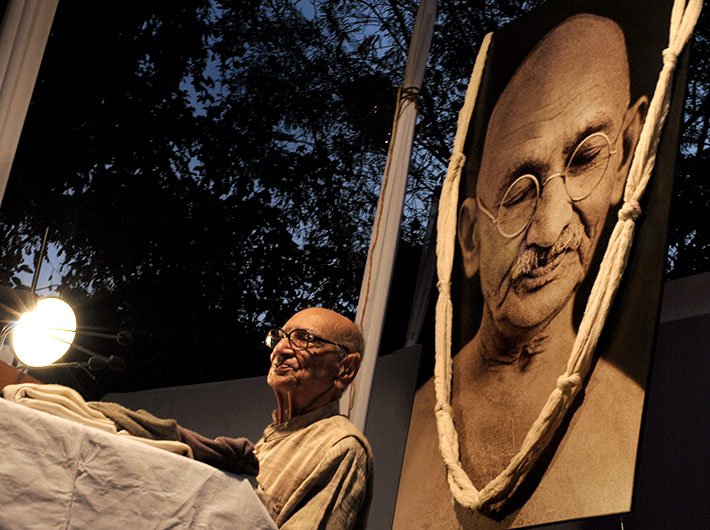He played with Gandhi in childhood, worked with Vinoba and JP, wrote two standard-reference biographies. Now in his 80s, Narayan Desai refuses to retire and strives to spread the good word
[This profile and interview of Narayan Desai, who passed away on Sunday, was published in Governance Now in the January 1-15, 2011 edition.]
An octogenarian, sitting on a dais close to a banyan tree on the lawns, was narrating Mahatma Gandhi’s life to a not-so-large audience. He might as well have been narrating his own life – not many people today can say they played with Gandhi in their childhood. As Narayan Desai, the only child of the Mahatma’s secretary Mahadev Desai, shared his reminiscences of Gandhi – from how he played with children in the ashrams to how he battled loneliness in his last phase; scholars, activists and students in the audience knew that this was the voice of the witness.
As the chirping birds in the trees went quiet and the voice spoke of the satyagraha in South Africa or the Dandi march or that fateful day of January 30, 1948, the listeners found themselves transformed into observers.
Desai did first Gandhi Katha in Kheda district of Gujarat in June 2004, two years after the communal violence in the state, and completed the 88th edition in New Delhi in November 2010.
“As a citizen, I feel I am responsible for all the social injustice – or if we use a religious term, paap (sin) – taking place around us. If Gandhi were around, he would have said, ‘I am guilty’. I thought: how could this happen in my Gujarat, rather than ‘Gandhi’s Gujarat’,” Desai says in a firm, strong voice that does not belie his age (he turned 86 on December 24, 2010).
“I carried out a peace march, adopted two children (of violence victims). Then I thought of doing some constructive work to repent my paap. The most influential model for constructive work I have seen in my life is Gandhi. Vinoba (Bhave) is also a very influential model, but Gandhi is the most influential. So I try to interpret him as much as I can and put my interpretations before people.”
These “interpretations” were first formulated in a four-volume, 2,300-page biography of the Mahatma that Desai published in 2003 (Gujarati edition: Maru Jivan E ja Mari Vani, Navjivan, Ahmedabad, and English edition, My Life is My Message, translated by Tridip Suhrud, Orient BlackSwan, 2009). Based on largely untapped sources like the legendary diaries of his father, the work has been hailed as one of the best among the 200-odd biographies of the Mahatma.
Of course, Desai’s lifelong practice of Gandhian ideals in a world increasingly challenging for that task was a crucial input to the biography.
“As I was sending the final installment of the manuscript to the press, I thought it had turned out to be a rather large work. How many people would read it? I was looking for a more popular medium to bring the Gandhi story to more and more people. I found that most periodicals and TV channels were directly or indirectly influenced by advertisers. I was looking for a medium which was not controlled by advertisements. I found katha to be such a medium.”
The Gandhi Katha seems to be modeled on the Ramayan and Bhagavat kathas (which is fine as well, given spiritual underpinnings of the Gandhi story), so the narration is interspersed with Gujarati or Hindi songs, some 60 of them written by Desai himself and sung by a team of singers.
The Katha narrates the whole story of Gandhi’s life from the birth to his assassination, and also highlights the moral values he brought to politics.
While most other biographers have focused on Gandhi’s political life, Desai feels his constructive programme and efforts towards spiritual purification have not been highlighted. “I find Gandhi’s satyagraha, constructive work and eleven vows (ekadash vrat – including truth, non-violence and celibacy) not only equally important but incomplete without each other,” he noted in the foreword to the biography. He presents the Gandhi Katha with the same orientation.
Desai aims to do 108 Gandhi Kathas, each lasting usually for three hours over five days. “Sometimes I feel it’s alright if I overexert, it does not matter if all my energy is drained in this process, but it would be better if I can do this more often. Of course, it would be better if I can do so while also taking care of my health. I feel it would be nice if I can do 108 kathas. At the rate of two events in a month, I should be able to achieve the target in 20 months,” Desai says with a smile.
The kathas have taken place in Gujarat (60), elsewhere in the country (23) and also abroad (five).
Though a crowd of less than 100 at the lawns of the India International Centre in New Delhi disappointed him (“In our Dethli village with a population of 5,000, there were more people in audience than here”), he is happy that the average age of the audience is coming down (“I see more and more youngsters now”).
Is that due to the revival of Gandhi as a popular icon among the youth after a series of films on the Mahatma? Desai thinks putting it that way would be very simplistic. “Those who used to encash the name of Gandhi no longer feel any need to do so. The Congress party does not feel so. Foreign leaders coming to India for arms trade no longer need to go to the Rajghat (to pay token obeisance). But the young generation does not have faith in politics; they don’t see a depth in today’s politics. So, some of them are turning to Gandhi.”
He adds, “Given the way people respond to the Gandhi Katha at various places, I have reasons to be satisfied.”

